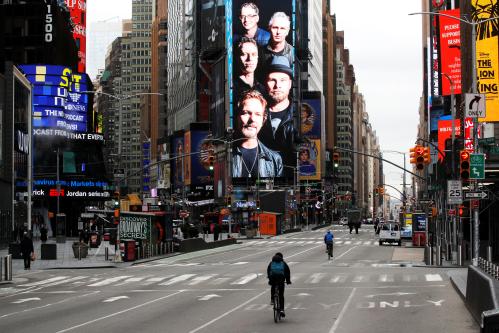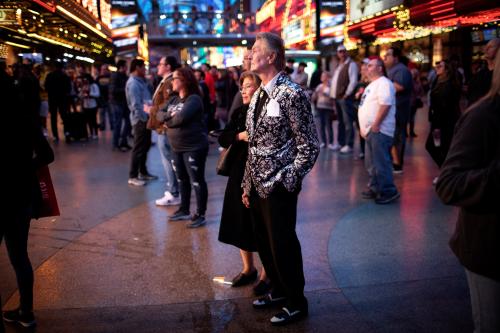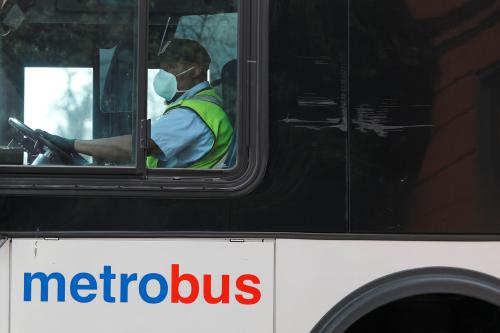With the national economy virtually immobilized as a result of the COVID-19 pandemic, it might seem like the crisis is going to mute the issue of regional economic divergence and its pattern of booming superstar cities and depressed, left-behind places.
But don’t be so sure about that. In fact, the pandemic might intensify the unevenness of America’s divergent economy, with disturbing implications.
The terrible logic and geography of the coronavirus implicates the global network of urban hubs, spokes, and hinterlands that has led to striking economic imbalance in advanced countries. While COVID-19 is spreading rapidly across the country, just three states—New York, New Jersey, and California—account for 53% of U.S. cases as of April 7. An earlier Brookings Metro analysis showed that the 50 counties with the most COVID-19 cases lie within metro areas that account for 48% of U.S. economic output and 44% of employment. In that sense, it is not surprising that the nation’s most globally connected cities—Seattle, New York City, and the San Francisco Bay Area—and their affluent suburbs were the ones hit earliest and hardest by the global pandemic.

The geographic pattern of the virus’s spread in the U.S., in other words, has only highlighted America’s superstar economic geography, albeit in a terrible way.
In light of this, some argue that the coronavirus could, if anything, help bring about a more geographically balanced economy. And indeed, it’s possible that many white-collar professionals working remotely for the first time will discover they can do their jobs from anywhere, inspiring moves to less expensive parts of the country that are in need of economic revitalization.
That’s been the prediction of plenty of futurists and visionaries who have long argued digital technology would bring about the “death of distance” and create a geographically untethered workforce, free to live and work wherever.
so what happens when tons of office workers start working from home for a while and find out that many of the jobs that require living in expensive cities can be done just fine by working from home, including in places where you can rent or buy a home for much much less money
— “Mark Berman” (@markberman) March 10, 2020
Don’t bet on it. Despite the increasing adoption of digital technology in American workplaces, economic activity has become more—not less—concentrated. It bears noting that in the decade following the Great Recession, the tech sector boomed in a way that greatly intensified the concentration of innovation workers and firms in just a few big cities—San Francisco, Seattle, New York, San Diego, Boston, and Austin, Texas. Nor did a long list of negative side effects of this hyperconcentration—bumper-to-bumper traffic, spiraling housing crises, an epidemic of homelessness—reverse the dynamic.
In that sense, while the density of large cities may be a disadvantage in fighting the spread of the coronavirus, it likely will remain an advantage in a 21st century knowledge economy, where the biggest places with the richest exchanges of ideas among highly educated workers have enjoyed the greatest economic returns. Some even anticipate that the “Big Tech” companies anchoring many of these superstar cities will become even bigger in the next few years, after having uniquely benefited from the coronavirus crisis. Already they are profiting from new demands for online messaging, telework, and streaming tools, and soon they will be able to leverage their huge cash hoards to buy up distressed rivals or troubled firms in other fields.
But not everyone living and working in the country’s superstar cities benefits from their dominance. Many individuals have not shared in the “winner-take-all” rewards of the superstar hubs and now find themselves acutely impacted by the public health crisis there. As our colleagues Martha Ross and Nicole Bateman write, low-wage workers—from food service employees to housekeepers—are now especially susceptible to the economic slowdown induced by the coronavirus. Many of these workers lack paid sick or vacation leave and confront potential layoffs due to the pandemic.
Large, superstar cities are also characterized by their expensive housing markets. Unaffordable housing in these cities has forced many residents into substandard living arrangements, overcrowded households, and homelessness. As Brookings’s Jenny Schuetz writes, these are conditions that make social distancing difficult.
So at the same time COVID-19 reflects the economic prominence of a handful of large, superstar cities, it also highlights the deep inequality within them.
Outside of the country’s urban centers, the outlook is similarly grim. Less densely populated areas may be confronting COVID-19 outbreaks later than urban areas, but rural populations face unique health care challenges in responding to them. While cities can address the health disadvantage of high population density by closing bars and restaurants and limiting public gatherings, rural areas cannot restore lost medical infrastructure overnight. Underinvestment in these communities—from the lack of high-speed, affordable broadband to declining employment opportunities—is mirrored in their health care systems, a reality that makes these communities particularly vulnerable now.
As the country slides into another recession, many of America’s less densely populated communities still haven’t recovered from the last one. Those that have, meanwhile, could see the revitalization achieved in recent years deteriorate as the economic fallout from the coronavirus hits the small businesses that anchor local communities and drive job creation.
By contrast, the nation’s largest cities, ones that accounted for the bulk of the nation’s job growth during the last recovery period, may be better positioned to bounce back quickly. As The Atlantic’s James Fallows writes, “Battered as even the superstar cities are at this frightening moment, no one doubts that some time they will be back strong.”
It will likely take years to fully grasp the unprecedented consequences of COVID-19, but the public health and economic crises it’s already precipitating threatens to further entrench regional inequality in America. Should a long-term recession materialize, there will be an opportunity and necessity to ensure that national economic relief reaches the country’s most vulnerable places.
The authors are grateful to research intern Roma Venkateswaran for her excellent research assistance.








Commentary
Will COVID-19 rebalance America’s uneven economic geography? Don’t bet on it.
April 13, 2020